Epistemic Discourses and Conceptual Coherence in Students’ Explanatory Models: The Case of Ocean Acidification and Its Impacts on Oysters
Abstract
:1. Introduction
2. Background
2.1. Modeling as an Epistemic Practice of Science and in Science Classrooms
2.2. Engaging in Models for a Systems Thinking Approach to Climate Change
2.3. Research Questions
3. Design and Methods
3.1. Context of the Study
3.2. Data Sources of the Study
3.3. Data Analysis Approach
4. Findings
4.1. Models as Epistemic Tools for Communicating Key Ideas Based on Evidence
4.1.1. Student Designed Investigation on Change in CO2 Amounts and pH Levels
4.1.2. Physical Interactive Model on Carbonate Challenge Activity
4.1.3. All about Oysters and Putting It All Together Activities
4.1.4. Scientific Representations Used in Students’ Explanatory Models
4.2. Levels of Cohesiveness in Explanatory Models
4.2.1. Explanatory Models with Extensive Explanation
4.2.2. Models with Sufficient Explanation
4.2.3. Models with Partial Explanation
4.2.4. Models with Insufficient Explanation
4.3. Systems Thinking: Moving beyond Oceans and Oysters
5. Discussions and Future Implications
5.1. Scaffolding Students for Engagement in Epistemic Aspects of Modeling
5.2. Diverse Discourse Modes for Building Cohesive Models
5.3. Systems Thinking beyond Oceans and Oysters
6. Conclusions and Limitations
Author Contributions
Funding
Institutional Review Board Statement
Informed Consent Statement
Data Availability Statement
Conflicts of Interest
References
- Gelfert, A. How to Do Science with Models: A Philosophical Primer; Springer: Berlin/Heidelberg, Germany, 2016. [Google Scholar]
- Gilbert, J.K. Models and modelling: Routes to more authentic science education. Int. J. Sci. Math. Educ. 2004, 2, 115–130. [Google Scholar] [CrossRef]
- Bokulich, A. How scientific models can explain. Synthese 2011, 180, 33–45. [Google Scholar] [CrossRef]
- Edmonds, B.; Le Page, C.; Bithell, M.; Chattoe-Brown, E.; Grimm, V.; Meyer, R.; Montañola Sales, C.; Ormerod, P.; Root, H.; Squazzoni, F. Diuerent modelling purposes. J. Artif. Soc. Soc. Simul. 2019, 22. [Google Scholar] [CrossRef]
- Passmore, C.; Stewart, J.; Cartier, J. Model-based inquiry and school science: Creating connections. Sch. Sci. Math. 2009, 109, 394–402. [Google Scholar] [CrossRef]
- Raghavan, K.; Glaser, R. Model–based analysis and reasoning in science: The MARS curriculum. Sci. Educ. 1995, 79, 37–61. [Google Scholar] [CrossRef]
- Windschitl, M.; Thompson, J.; Braaten, M. Beyond the scientific method: Model-based inquiry as a new paradigm of preference for school science investigations. Sci. Educ. 2008, 92, 941–967. [Google Scholar] [CrossRef]
- National Research Council. A Framework for K-12 Science Education: Practices, Crosscutting Concepts, and Core Ideas; National Academies Press: Washington, DC, USA, 2012. [Google Scholar]
- NGSS Lead States. Next Generation Science Standards: For States, by States; The National Academies Press: Washington, DC, USA, 2013. [Google Scholar]
- Baek, H.; Schwarz, C.; Chen, J.; Hokayem, H.; Zhan, L. Engaging elementary students in scientific modeling: The MoDeLS fifth-grade approach and findings. In Models and Modeling: Cognitive Tools for Scientific Enquiry; Springer: Berlin/Heidelberg, Germany, 2011; pp. 195–218. [Google Scholar]
- Rudolph, J.L. Portraying epistemology: School science in historical context. Sci. Educ. 2003, 87, 64–79. [Google Scholar] [CrossRef]
- Ke, L.; Schwarz, C.V. Using epistemic considerations in teaching: Fostering students’ meaningful engagement in scientific modeling. In Towards a Competence-Based View on Models and Modeling in Science Education; Springer: Berlin/Heidelberg, Germany, 2019; pp. 181–199. [Google Scholar]
- Lehrer, R.; Schauble, L. Cultivating Model-Based Reasoning in Science Education; Cambridge University Press: Cambridge, UK, 2006. [Google Scholar]
- Schwarz, C.V.; Passmore, C.; Reiser, B.J. Helping Students Make Sense of the World using Next Generation Science and Engineering Practices; NSTA Press: Arlington, VA, USA, 2017. [Google Scholar]
- Windschitl, M.; Thompson, J.; Braaten, M. Ambitious Science Teaching; Harvard Education Press: Cambridge, MA, USA, 2020. [Google Scholar]
- Guy-Gaytán, C.; Gouvea, J.S.; Griesemer, C.; Passmore, C. Tensions between learning models and engaging in modeling: Exploring implications for science classrooms. Sci. Educ. 2019, 28, 843–864. [Google Scholar] [CrossRef]
- Schwarz, C.V.; Reiser, B.J.; Davis, E.A.; Kenyon, L.; Achér, A.; Fortus, D.; Shwartz, Y.; Hug, B.; Krajcik, J. Developing a learning progression for scientific modeling: Making scientific modeling accessible and meaningful for learners. J. Res. Sci. Teach. 2009, 46, 632–654. [Google Scholar] [CrossRef]
- Windschitl, M.; Thompson, J. The modeling toolkit: Making student thinking visible with public representations. Sci. Teach. 2013, 80, 63–69. [Google Scholar]
- Intergovernmental Panel on Climate Change. Global Warming of 1.5 °C: An IPCC Special Report on the Impacts of Global Warming of 1.5 °C Above Pre-industrial Levels and Related Global Greenhouse Gas Emission Pathways, in the Context of Strengthening the Global Response to the Threat of Climate Change, Sustainable Development, and Efforts to Eradicate Poverty; World Meteorological Organization.: Geneva, Switzerland, 2018. [Google Scholar]
- Jang, S.M.; Hart, P.S. Polarized frames on “climate change” and “global warming” across countries and states: Evidence from Twitter big data. Glob. Environ. Change 2015, 32, 11–17. [Google Scholar] [CrossRef]
- Plutzer, E.; McCaffrey, M.; Hannah, A.L.; Rosenau, J.; Berbeco, M.; Reid, A.H. Climate confusion among US teachers. Science 2016, 351, 664–665. [Google Scholar] [CrossRef] [PubMed]
- Hadorn, G.H.; Hoffmann-Riem, H.; Biber-Klemm, S.; Grossenbacher-Mansuy, W.; Joye, D.; Pohl, C.; Wiesmann, U.; Zemp, E. Handbook of Transdisciplinary Research; Springer: Berlin/Heidelberg, Germany, 2008. [Google Scholar]
- Ke, L.; Sadler, T.D.; Zangori, L.; Friedrichsen, P.J. Students’ perceptions of socio-scientific issue-based learning and their appropriation of epistemic tools for systems thinking. Int. J. Sci. Educ. 2020, 42, 1339–1361. [Google Scholar] [CrossRef]
- Kelly, G. Inquiry, activity and epistemic practice. In Teaching Scientific Inquiry; Brill: Leiden, The Netharlands, 2008; pp. 99–117. [Google Scholar]
- Knorr-Cetina, K.D. Epistemic cultures: Forms of reason in science. Hist. Political Econ. 1991, 23, 105–122. [Google Scholar] [CrossRef]
- Knorr Cetina, K. Epistemic Cultures: How the Sciences make Knowledge; Harvard University Press: Cambridge, MA, USA, 1999. [Google Scholar]
- Gouvea, J.; Passmore, C. ‘Models of’versus ‘Models for’ Toward an Agent-Based Conception of Modeling in the Science Classroom. Sci. Educ. 2017, 26, 49–63. [Google Scholar] [CrossRef]
- Kelly, G.J. Methodological considerations for the study of epistemic cognition in practice. In Handbook of Epistemic Cognition; Routledge: London, UK, 2016; pp. 393–408. [Google Scholar]
- Stroupe, D. Examining classroom science practice communities: How teachers and students negotiate epistemic agency and learn science-as-practice. Sci. Educ. 2014, 98, 487–516. [Google Scholar] [CrossRef]
- Crawford, B.A.; Capps, D.K. Teacher cognition of engaging children in scientific practices. In Cognition, Metacognition, and Culture in STEM Education: Learning, Teaching and Assessment; Springer: Berlin/Heidelberg, Germany, 2018; pp. 9–32. [Google Scholar]
- Pluta, W.J.; Chinn, C.A.; Duncan, R.G. Learners’ epistemic criteria for good scientific models. J. Res. Sci. Teach. 2011, 48, 486–511. [Google Scholar] [CrossRef]
- Giere, R.N. Explaining Science: A Cognitive Approach; University of Chicago Press: Chicago, IL, USA, 2010. [Google Scholar]
- Kuhn, T. The Essential Tension; University of Chicago Press: Chicago, IL, USA, 1977. [Google Scholar]
- Goldman, A.I. Knowledge in a Social World; Oxford University Press: Oxford, UK, 1999. [Google Scholar]
- Solomon, M. Social Empiricism; MIT Press: Cambridge, MA, USA, 2007. [Google Scholar]
- Bishop, M.A.; Bishop, M.A.; Trout, J. Epistemology and the Psychology of Human Judgment; Oxford University Press on Demand: Oxford, UK, 2005. [Google Scholar]
- Machamer, P.; Darden, L.; Craver, C.F. Thinking about mechanisms. Philos. Sci. 2000, 67, 1–25. [Google Scholar] [CrossRef]
- Staley, K.W. Robust evidence and secure evidence claims. Philos. Sci. 2004, 71, 467–488. [Google Scholar] [CrossRef]
- Bamberger, Y.M.; Davis, E.A. Middle-school science students’ scientific modelling performances across content areas and within a learning progression. Int. J. Sci. Educ. 2013, 35, 213–238. [Google Scholar] [CrossRef]
- Fortus, D.; Shwartz, Y.; Rosenfeld, S. High school students’ meta-modeling knowledge. Res. Sci. Educ. 2016, 46, 787–810. [Google Scholar] [CrossRef]
- Pierson, A.E.; Clark, D.B.; Sherard, M.K. Learning progressions in context: Tensions and insights from a semester-long middle school modeling curriculum. Sci. Educ. 2017, 101, 1061–1088. [Google Scholar] [CrossRef]
- Heijnes, D.; van Joolingen, W.; Leenaars, F. Stimulating scientific reasoning with drawing-based modeling. J. Sci. Educ. Technol. 2018, 27, 45–56. [Google Scholar] [CrossRef]
- Tytler, R. The Role of Visualisation in Science: A Response to “Science Teachers’ Use of Visual Representations” Science Teachers’ Use of Visual Representations, edited by Eilam, B. and Gilbert, J., Dordrecht, The Netherlands, Springer, 2014, VIII+ 338pp.,£ 90.00, ISBN 978-3-319-06525-0; Taylor & Francis: Singapore, 2021. [Google Scholar]
- Zhai, X.; He, P.; Krajcik, J. Applying machine learning to automatically assess scientific models. J. Res. Sci. Teach. 2022, 59, 1765–1794. [Google Scholar] [CrossRef]
- Tversky, B. Spatial schemas in depictions. In Spatial Schemas and Abstract Thought; MIT Press: Boston, MA, USA, 2001; Volume 79, p. 111. [Google Scholar]
- Ainsworth, S. DeFT: A conceptual framework for considering learning with multiple representations. Learn. Instr. 2006, 16, 183–198. [Google Scholar] [CrossRef]
- Cheng, M.-F.; Lin, J.-L.; Lin, S.-Y.; Cheng, C.-H. Scaffolding middle school and high school students’ modeling processes. J. Balt. Sci. Educ. 2017, 16, 207. [Google Scholar] [CrossRef]
- Frydenberg, E. My journey in coping research and practice: The impetus and the relevance. Educ. Dev. Psychol. 2020, 37, 83–90. [Google Scholar] [CrossRef]
- Sinatra, G.M.; Lombardi, D. Evaluating sources of scientific evidence and claims in the post-truth era may require reappraising plausibility judgments. Educ. Psychol. 2020, 55, 120–131. [Google Scholar] [CrossRef]
- McGowan, V.C.; Bell, P. “I now deeply care about the effects humans are having on the world”: Cultivating ecological care and responsibility through complex systems modelling and investigations. Educ. Dev. Psychol. 2022, 39, 116–131. [Google Scholar] [CrossRef]
- Senge, P. The fifth discipline: The art and practice of the learning organization; Doubleday: New York, NY, USA, 1990. [Google Scholar]
- Davidz, H.L.; Nightingale, D.J. Enabling systems thinking to accelerate the development of senior systems engineers. Syst. Eng. 2008, 11, 1–14. [Google Scholar] [CrossRef]
- Goldstone, R.L.; Wilensky, U. Promoting transfer by grounding complex systems principles. J. Learn. Sci. 2008, 17, 465–516. [Google Scholar] [CrossRef]
- King, C.; Jiggins, J.; Coutts, J. Organisational Skills for Overcoming the Invisable Process Barriers to Ecological Sustainable Development (ESD). In Proceedings of the Management for Ecological Sustainability, Brisbane, Australia, September 1998; Centre for Conservation Biology, University of Queensland: Brisbane, Australia, 2000. [Google Scholar]
- Leischow, S.J.; Milstein, B. Systems Thinking and Modeling for Public Health Practice; American Public Health Association: Washington, DC, USA, 2006; Volume 96, pp. 403–405. [Google Scholar]
- Grossi, A.; Dinku, T. Enhancing national climate services: How systems thinking can accelerate locally led adaptation. One Earth 2022, 5, 74–83. [Google Scholar] [CrossRef]
- Hmelo-Silver, C.E.; Marathe, S.; Liu, L. Fish swim, rocks sit, and lungs breathe: Expert-novice understanding of complex systems. J. Learn. Sci. 2007, 16, 307–331. [Google Scholar] [CrossRef]
- Verhoeff, R.P.; Knippels, M.-C.P.; Gilissen, M.G.; Boersma, K.T. The theoretical nature of systems thinking. Perspectives on systems thinking in biology education. In Frontiers in Education; Frontiers Media SA: Lausanne, Switzerland, 2018; Volume 3, p. 40. [Google Scholar]
- van Ravenzwaaij, J.; Olde Hartman, T.C.; Van Ravesteijn, H.; Eveleigh, R.; Van Rijswijk, E.; Lucassen, P. Explanatory models of medically unexplained symptoms: A qualitative analysis of the literature. Ment. Health Fam. Med. 2010, 7, 223. [Google Scholar] [PubMed]
- Wilensky, U.; Reisman, K. Thinking like a wolf, a sheep, or a firefly: Learning biology through constructing and testing computational theories—An embodied modeling approach. Cogn. Instr. 2006, 24, 171–209. [Google Scholar] [CrossRef]
- Pörtner, H.; Karl, D.; Boyd, P.; Cheung, W.; Lluch-Cota, S.; Nojiri, Y.; Schmidt, D.; Zavialov, P.; Alheit, J.; Aristegui, J. Ocean Systems. Climate Change 2014: Impacts, Adaptation, and Vulnerability. Part A: Global and Sectoral Aspects. Contribution of Working Group II to the Fifth Assessment Report of the Intergovernmental Panel on Climate Change; Cambridge University Press: Cambridge, UK, 2014; pp. 411–484. [Google Scholar]
- Gold, A.U.; Oonk, D.J.; Smith, L.; Boykoff, M.T.; Osnes, B.; Sullivan, S.B. Lens on climate change: Making climate meaningful through student-produced videos. J. Geogr. 2015, 114, 235–246. [Google Scholar] [CrossRef]
- Bezemer, J.; Jewitt, C.; Diamantopoulou, S.; Kress, G.; Mavers, D. Using a social semiotic approach to multimodality: Researching learning in schools, museums and hospitals. NCRM Working Paper 2012. Available online: http://eprints.ncrm.ac.uk/2258/4/NCRM_working_paper_0112.pdf (accessed on 21 March 2023).
- Kress, G. Discourse analysis and education: A multimodal social semiotic approach. In An Introduction to Critical Discourse Analysis in Education; Routledge: London, UK, 2011; pp. 205–226. [Google Scholar]
- Lemke, J.L. Articulating Communities: Sociocultural Perspectives on Science Education. J. Res. Sci. Teach. 2001, 38, 296–316. [Google Scholar] [CrossRef]
- Glaser, B.G. The constant comparative method of qualitative analysis. Soc. Probl. 1965, 12, 436–445. [Google Scholar] [CrossRef]
- Syed, M.; Nelson, S.C. Guidelines for establishing reliability when coding narrative data. Emerg. Adulthood 2015, 3, 375–387. [Google Scholar] [CrossRef]
- Reiser, B.J. What professional development strategies are needed for successful implementation of the Next Generation Science Standards. In Invitational Research Symposium on Science Assessment; ETS: Washington, DC, USA, 2013; pp. 1–22. [Google Scholar]
- Reiser, B.J.; Novak, M.; McGill, T.A.; Penuel, W.R. Storyline units: An instructional model to support coherence from the students’ perspective. J. Sci. Teach. Educ. 2021, 32, 805–829. [Google Scholar] [CrossRef]
- Rudolph, J.L. Inquiry, instrumentalism, and the public understanding of science. Sci. Educ. 2005, 89, 803–821. [Google Scholar] [CrossRef]
- Smith, C.L.; Maclin, D.; Houghton, C.; Hennessey, M.G. Sixth-grade students’ epistemologies of science: The impact of school science experiences on epistemological development. Cogn. Instr. 2000, 18, 349–422. [Google Scholar] [CrossRef]
- Ainsworth, S.; Prain, V.; Tytler, R. Drawing to learn in science. Science 2011, 333, 1096–1097. [Google Scholar] [CrossRef] [PubMed]
- Guinotte, J.M.; Fabry, V.J. Ocean acidification and its potential effects on marine ecosystems. Ann. New York Acad. Sci. 2008, 1134, 320–342. [Google Scholar] [CrossRef] [PubMed]
- Tschakert, P.; Schlosberg, D.; Celermajer, D.; Rickards, L.; Winter, C.; Thaler, M.; Stewart-Harawira, M.; Verlie, B. Multispecies justice: Climate-just futures with, for and beyond humans. Wiley Interdiscip. Rev. Clim. Change 2021, 12, e699. [Google Scholar] [CrossRef]
- Celermajer, D.; Chatterjee, S.; Cochrane, A.; Fishel, S.; Neimanis, A.; O’brien, A.; Reid, S.; Srinivasan, K.; Schlosberg, D.; Waldow, A. Justice through a multispecies lens. Contemp. Political Theory 2020, 19, 475–512. [Google Scholar] [CrossRef]
- National Research Council. Developing Assessments for the Next Generation Science Standards; National Academies Press: Washington, DC, USA, 2014. [Google Scholar]
- Penuel, W.R. Reimagining american education: Possible futures: Possible futures for equitable educational assessment. Phi Delta Kappan 2021, 103, 54–57. [Google Scholar] [CrossRef]
- National Academy of Sciences. Educational assessments in the COVID-19 era and beyond. PowerPoint slides 2021. 2021. Available online: https://naeducation.org/wp-content/uploads/2021/03/Educational-Assessments-in-the-COVID-19-Era-and-Beyond_NAEd-Forum-Combined-Slides.pdf (accessed on 21 March 2023).
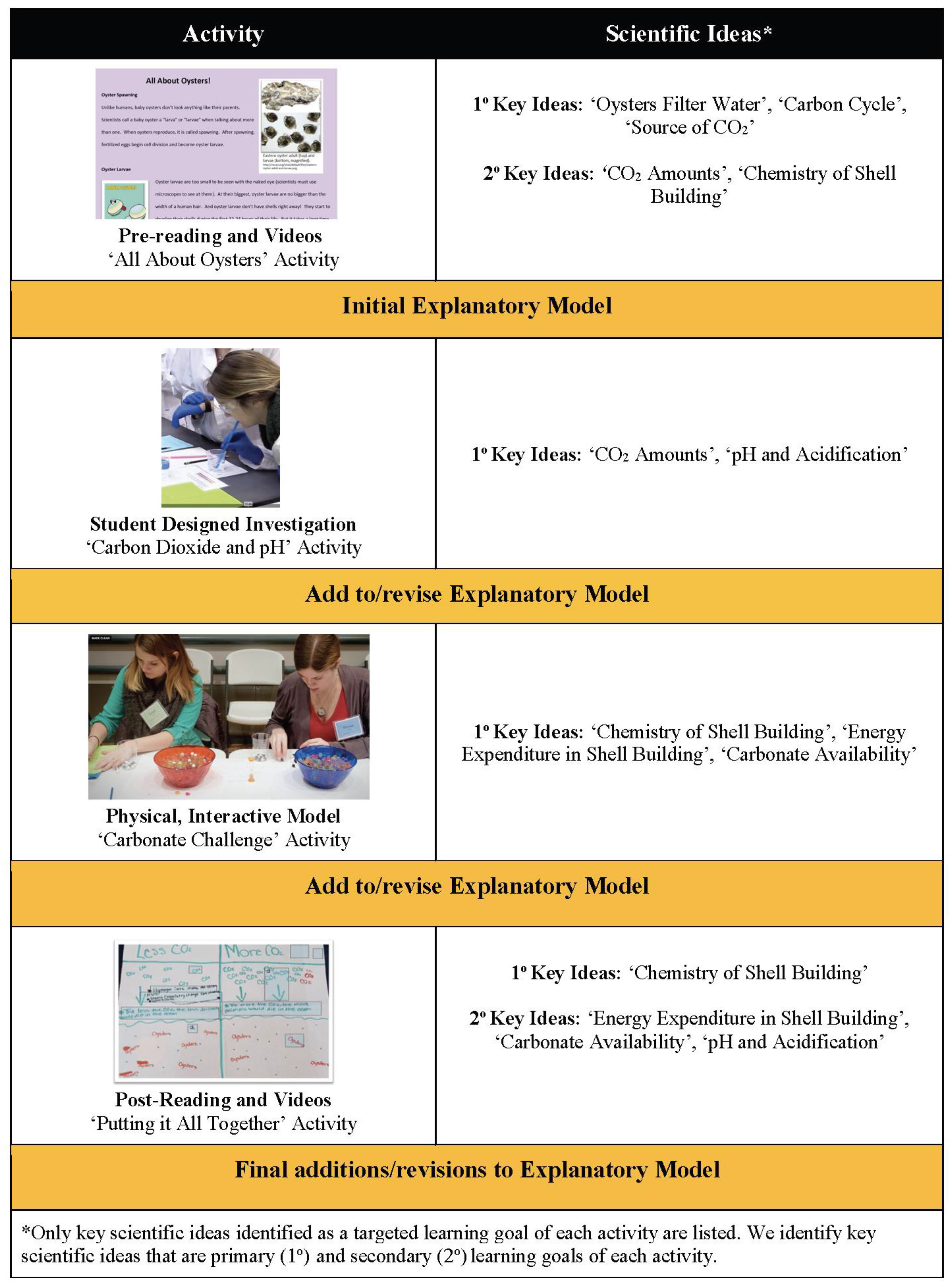
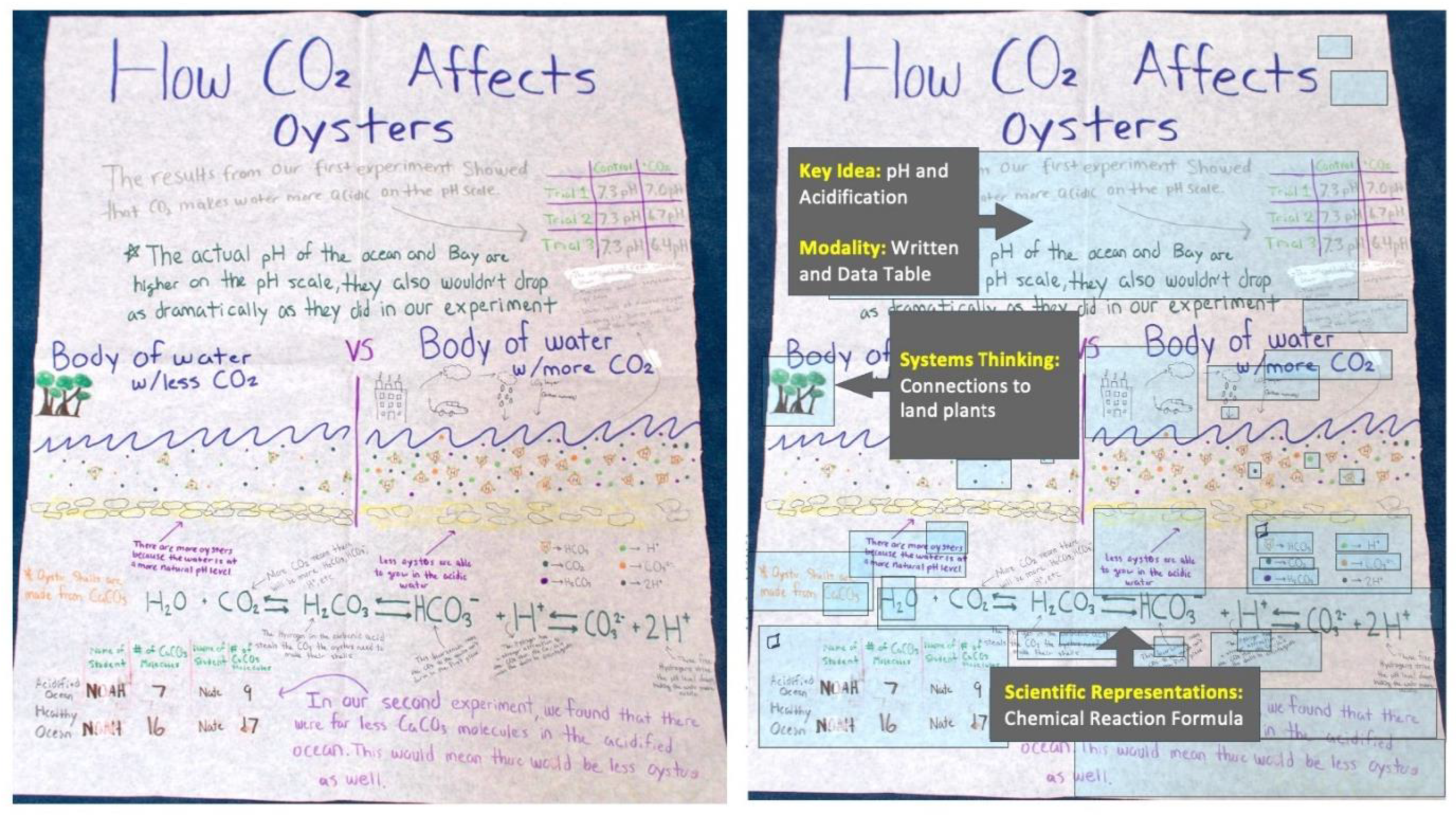

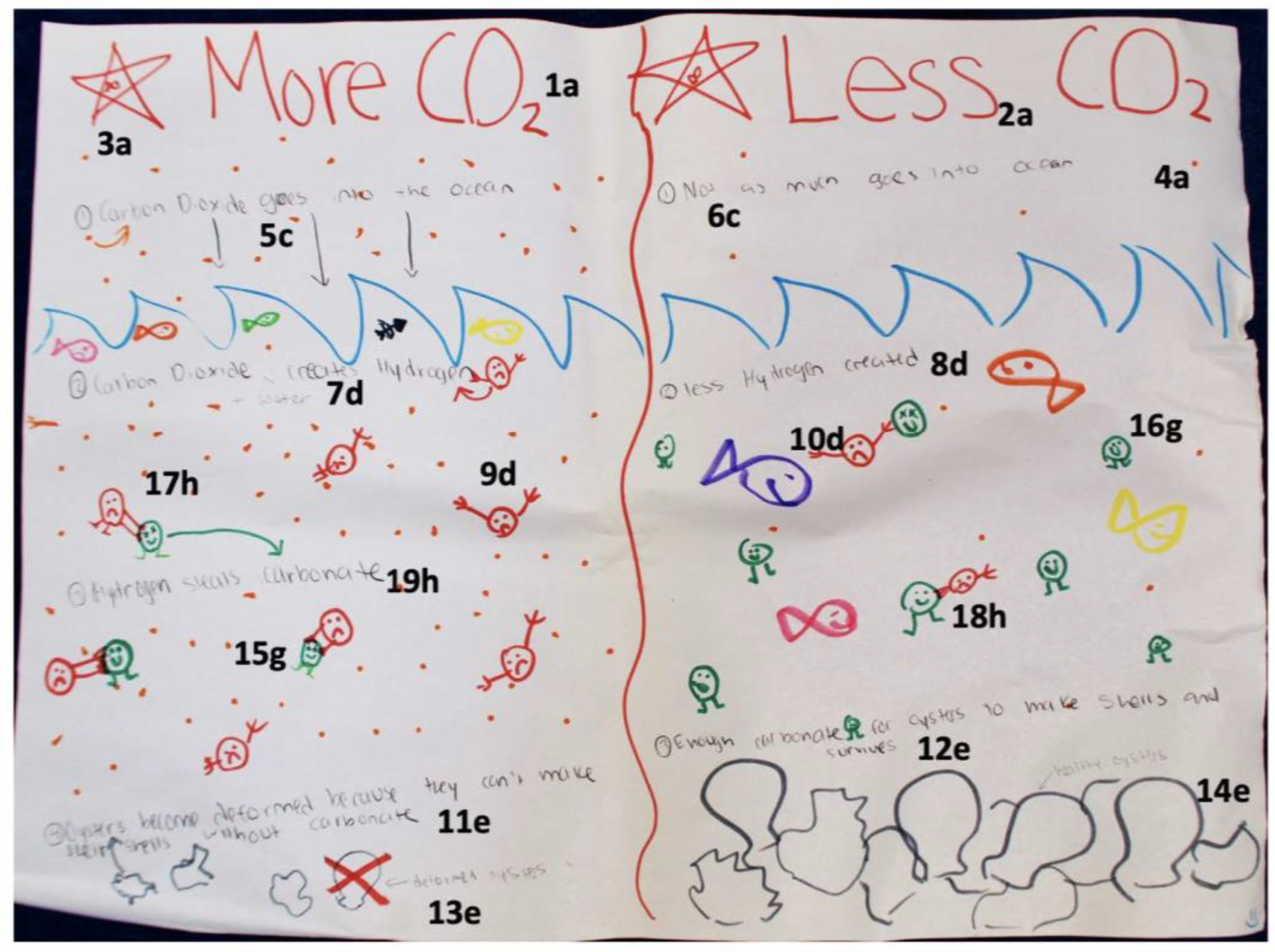
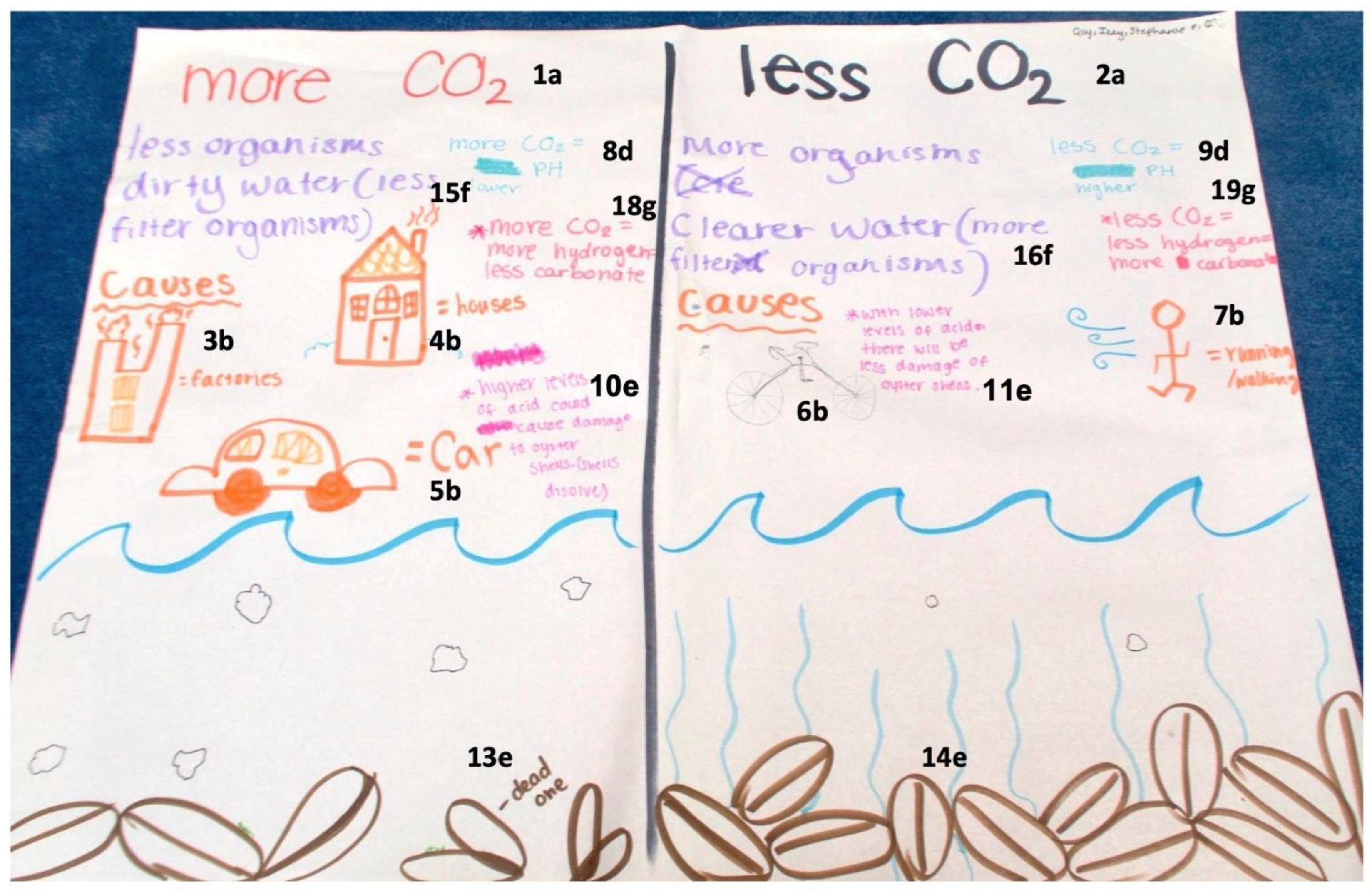

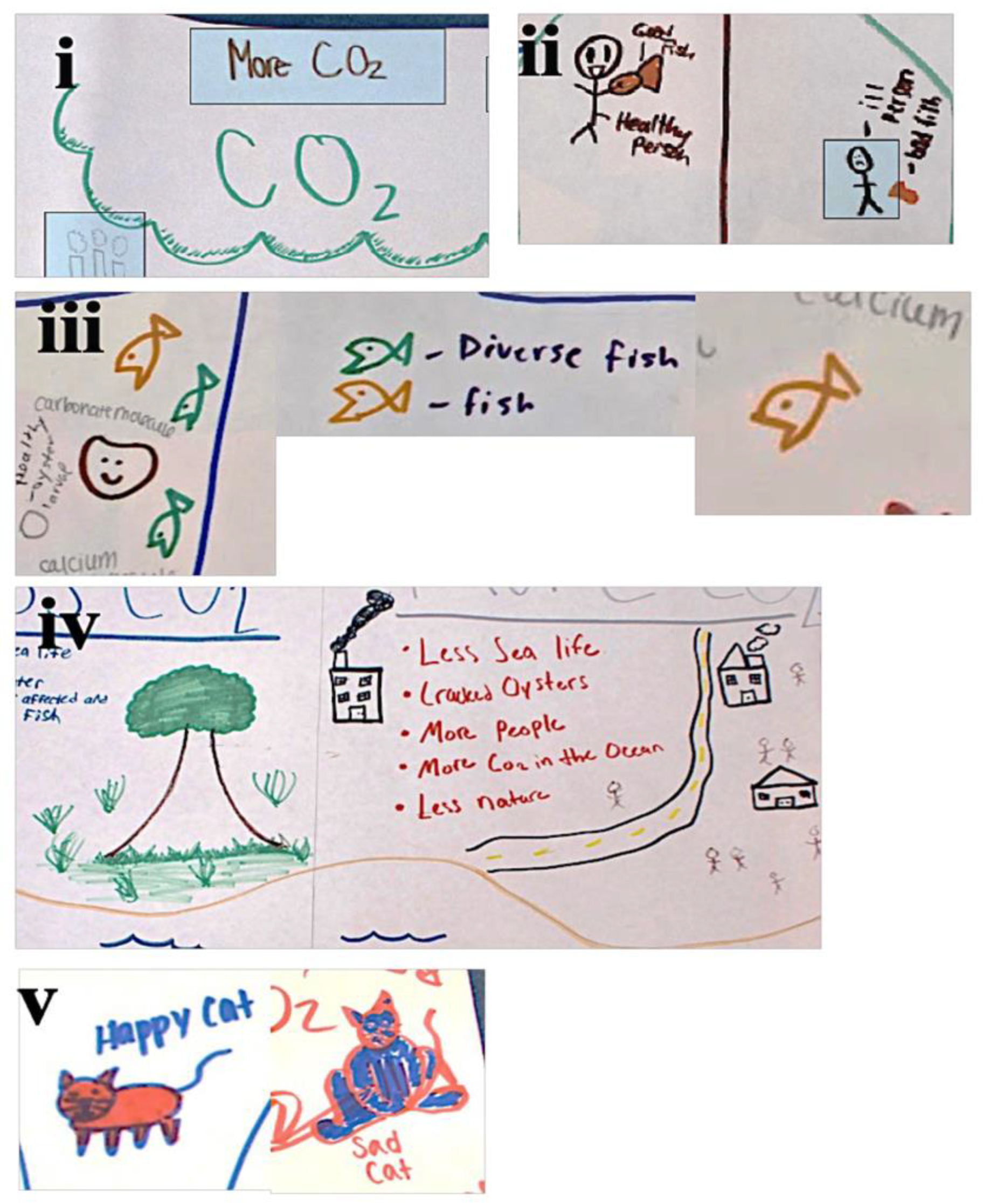
| Teacher Pseudonym | Grade and Course Type | # Student- Groups Creating Explanatory Models | School Location | Demographics (Percentages) of Student Population | ||||||
|---|---|---|---|---|---|---|---|---|---|---|
| White | Asian | African American | Hispanic | American Indian | HI/ Pac. Isl. a | Two/More Races | ||||
| Avery | 9 | 7 | Rural | 81.0 | 1.1 | 8.2 | 6.8 | 0 | 0 | 2.7 |
| Denmark | 7 | 5 | Suburban | 49.6 | 5.8 | 25.2 | 13.2 | 0 | 0 | 5.6 |
| Dylan | 8/8GT b | 6/7 | Urban | 1.0 | 0.2 | 93.9 | 4.6 | 0.1 | 0.2 | 0.2 |
| Haverford | 7 | 6 | Suburban | 2.1 | 2.4 | 88.2 | 3.9 | 0.2 | 0 | 3.3 |
| Kelsey | 6 | 13 | Suburban | 49.6 | 5.8 | 25.2 | 13.2 | 0 | 0 | 5.6 |
| Libby | 6 | 21 | Urban | 53.2 | 5.0 | 17.6 | 17.8 | 0 | 0 | 6.1 |
| Lopez | 8 Honors | 8 | Suburban | 82.5 | 4.9 | 3.0 | 6.9 | 0 | 0 | 2.2 |
| Munz | 9–12 AP c | 11 | Rural | 78.6 | 0 | 7.1 | 9.2 | 0 | 0 | 4.2 |
| Sandoval | 8 GT Env. d | 5 | Suburban | 19.3 | 4.5 | 62.6 | 9.5 | 0 | 0 | 3.5 |
| Smith | 6 | 6 | Suburban | 82.6 | 0.0 | 7.2 | 5.1 | 0 | 0 | 3.1 |
| Thomas | 10/10 Inc. e | 6/38 | Suburban | 82.7 | 2.4 | 5.5 | 4.5 | 0 | 0 | 4.3 |
| Williams | 9 | 11 | Rural | 90.5 | 1.3 | 2.0 | 2.4 | 0 | 0 | 3.4 |
| Teacher | Years Teaching | Experience Teaching Climate Change |
|---|---|---|
| Avery | 23 | No |
| Denmark | 17 | Yes |
| Dylan | 15 | No |
| Haverford | 7.5 | No |
| Kelsey | 10 | No |
| Libby | 8 | No |
| Lopez | 7 | No |
| Munz | 12 | No |
| Sandoval | 16 | Yes |
| Smith | 17 | No |
| Thomas | 17 | No |
| Williams | 11 | Yes |
| Key Ideas | # Explanatory Models (Out of 150) | Drawn | Written | Drawn & Written | Data Table | Drawn & Written & Data Table | Written & Data Table | # Total Codes (Out of 1928) |
|---|---|---|---|---|---|---|---|---|
| Energy Expenditure in Shell Building | 145 | 127 | 189 | 146 | 1 | 0 | 1 | 464 |
| CO2 Amounts | 131 | 112 | 229 | 115 | 0 | 0 | 2 | 458 |
| pH and Acidification | 117 | 30 | 217 | 77 | 9 | 1 | 7 | 341 |
| Carbonate Availability | 85 | 52 | 84 | 35 | 1 | 3 | 5 | 180 |
| Source of CO2 | 74 | 68 | 33 | 44 | 0 | 0 | 0 | 145 |
| Chemistry of Shell Building | 71 | 11 | 73 | 50 | 1 | 1 | 3 | 139 |
| Carbon Cycle | 65 | 32 | 51 | 40 | 0 | 0 | 0 | 123 |
| Oysters Filter Water | 41 | 2 | 52 | 24 | 0 | 0 | 0 | 78 |
| Key Ideas | Molecular Formula | Written Molecule/ Element Names | Arrows for Processes and Relationship | Key or Label | Chemical Reaction Formulas | Dots For Molecules | Circles as Molecules |
|---|---|---|---|---|---|---|---|
| CO2 Amounts | 49 | 12 | 11 | 8 | 2 | 2 | 9 |
| pH and Acidification | 62 | 30 | 13 | 3 | 22 | 1 | 8 |
| Carbon Cycle | 9 | 6 | 22 | 1 | 1 | 1 | 2 |
| Chemistry of Shell Building | 32 | 53 | 4 | 4 | 4 | 0 | 11 |
| Energy Expenditure in Shell Building | 23 | 44 | 8 | 14 | 3 | 0 | 7 |
| Oysters Filter Water | 1 | 1 | 1 | 1 | 0 | 1 | 1 |
| Carbonate Availability | 20 | 48 | 4 | 2 | 5 | 0 | 7 |
| Source of CO2 | 5 | 1 | 7 | 6 | 0 | 0 | 0 |
| Total # of Scientific Representations | 201 | 195 | 70 | 39 | 37 | 5 | 45 |
| Levels of Cohesiveness for Explanatory Models | Description of Model Characteristics for (1) Responding to Phenomena, (2) Key Ideas, (3) Connections between Key Ideas | Example |
|---|---|---|
| Explanatory Models with Extensive Explanation | Models in the ‘Extensive’ category communicated accurately, and with enough detail, the phenomena in response to the driving question. To communicate a coherent, cohesive, sequential, and gapless explanation, the models included evidence from activities to support almost all key ideas and showed clear connections among these key ideas. | Figure 3 |
| Models with Sufficient Explanation | Similar to the ‘Extensive’ category, models categorized as ‘Sufficient’ included mostly complete explanations of the driving question. However, unlike the ‘Extensive’ categories, these models lacked and/or misrepresented more than one key idea. They also tended to include fewer pieces of evidence from the module’s activities. | Figure 4 |
| Models with Partial Explanation | These models demonstrate a ‘Partial’ level of cohesiveness when explaining the phenomena to answer the driving question. Models in this category provide a ‘Partial’ explanation and generally only respond to one of the two investigative questions of the module. More than a few key ideas may be missing and/or student representations of these ideas might not align with the scientific findings. Furthermore, these models miss critical connections among key ideas which generally lead to gaps in their explanations. | Figure 5 |
| Models with Insufficient Explanation | The models in this category did not provide a sufficiently cohesive explanation of the phenomena. Very few key ideas were present and/or the scientific ideas were mostly disconnected. | Figure 6 |
Disclaimer/Publisher’s Note: The statements, opinions and data contained in all publications are solely those of the individual author(s) and contributor(s) and not of MDPI and/or the editor(s). MDPI and/or the editor(s) disclaim responsibility for any injury to people or property resulting from any ideas, methods, instructions or products referred to in the content. |
© 2023 by the authors. Licensee MDPI, Basel, Switzerland. This article is an open access article distributed under the terms and conditions of the Creative Commons Attribution (CC BY) license (https://creativecommons.org/licenses/by/4.0/).
Share and Cite
Sezen-Barrie, A.; Stapleton, M.K.; Marbach-Ad, G.; Miller-Rushing, A. Epistemic Discourses and Conceptual Coherence in Students’ Explanatory Models: The Case of Ocean Acidification and Its Impacts on Oysters. Educ. Sci. 2023, 13, 496. https://doi.org/10.3390/educsci13050496
Sezen-Barrie A, Stapleton MK, Marbach-Ad G, Miller-Rushing A. Epistemic Discourses and Conceptual Coherence in Students’ Explanatory Models: The Case of Ocean Acidification and Its Impacts on Oysters. Education Sciences. 2023; 13(5):496. https://doi.org/10.3390/educsci13050496
Chicago/Turabian StyleSezen-Barrie, Asli, Mary K. Stapleton, Gili Marbach-Ad, and Anica Miller-Rushing. 2023. "Epistemic Discourses and Conceptual Coherence in Students’ Explanatory Models: The Case of Ocean Acidification and Its Impacts on Oysters" Education Sciences 13, no. 5: 496. https://doi.org/10.3390/educsci13050496
APA StyleSezen-Barrie, A., Stapleton, M. K., Marbach-Ad, G., & Miller-Rushing, A. (2023). Epistemic Discourses and Conceptual Coherence in Students’ Explanatory Models: The Case of Ocean Acidification and Its Impacts on Oysters. Education Sciences, 13(5), 496. https://doi.org/10.3390/educsci13050496







